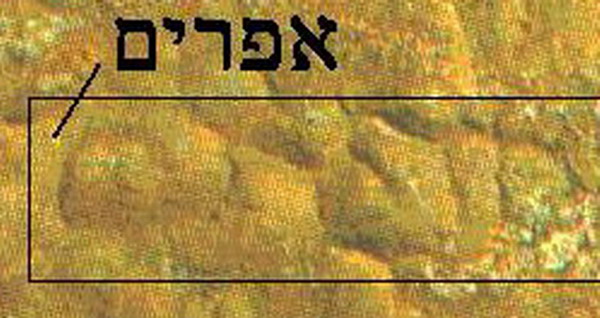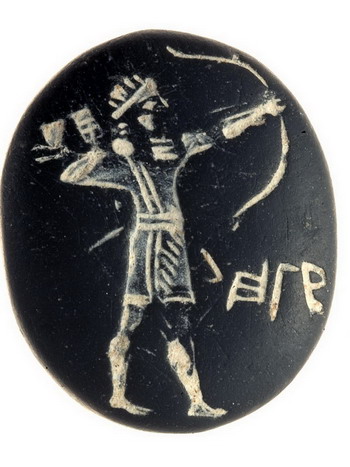The name "Ephraim" in Hebrew Letters as Seen
by Satellite in the Hills of Ephraim

The name "Ephraim" in Hebrew Letters as Seen
by Satellite in the Hills of Ephraim

For Previous issues see:
BAMBINO ARCHIVE
BRIT-AM BIBLICAL ISRAEL NEWS ONLINE
The Most Recent Issues

| Site Contents by Subject |
Home Research Revelation Reconciliation |
Publications |
Site Map Contents in Alphabetical Order |
This Site |
|

|
An image of a warrior shooting an arrow is depicted on the seal, which belonged
to a Hebrew person by the name of Hagab. The owner of the seal probably held a
military position, possibly that of army commander of the Kingdom of Judah. The seal, was discovered in the excavations that are being conducted by the Israel Antiquities Authority, at the behest of the Western Wall Heritage Foundation, will be presented to the public at a joint study day of the Israel Antiquities Authority and the Hebrew University of Jerusalem. |
Return of the kings
By Bruce Bower
Extracts:
Contested evidence from an ancient site may reunite archaeology
with Biblical accounts of Kings David and Solomon
MINING CONTROVERSY Remains of a structure perch on the edge of a copper slag
mound excavated to a depth of more than six meters at Khirbat en-Nahas in
southern Jordan. A new study concludes that industrial-scale copper production
occurred there 3,000 years ago, suggesting that biblical kings controlled what
was once a major settlement.
New finds among the remnants of a settlement in southern Jordan show that a
copper-producing society existed there 3,000 years ago, about 300 years earlier
than many archaeologists had assumed, according to an international research
team. The site's revised age raises the controversial possibility that, in line
with Old Testament accounts, Israel's King David and his son Solomon controlled
copper production in southern Jordan, says archaeologist and team leader Thomas
Levy of the University of California, San Diego.
A long-disputed claim that King Solomon's copper mines were located near the
Jordanian site must now be taken seriously, the investigators report in the Oct.
28 Proceedings of the National Academy of Sciences.
"We have conclusively shown that industrial-scale copper production occurred at
this site in the 10th and ninth centuries B.C., which resonates with Old
Testament descriptions of vibrant, complex societies in the same area at that
time," Levy says.
Since 2002, Levy and his colleagues have excavated an ancient copper-producing
site called Khirbat en-Nahas, which means "ruins of copper" in Arabic. The site
lies in a lowland, arid region south of the Dead Sea. Biblical writings identify
this area as Edom, home to a kingdom that barred Moses during the Exodus and
warred with King David.
In 2006, the researchers excavated down to virgin soil, slicing through more
than six meters of industrial smelting debris, or slag. A special software
program used 20 new radiocarbon dates and other evidence from the excavation to
generate a chronology of the site.
"In calling for a new dialogue between scientific dating techniques and
historical sources, especially the Bible, these new results support the
possibility that Solomon's mines in the region near the Dead Sea may be dated to
the 10th or ninth centuries B.C.," says archaeologist Eric Meyers of Duke
University in Durham, N.C.
Scholars have long argued about whether Edom was organized as a kingdom early
enough to have threatened the Israelites. During the 1930s, archaeologist Nelson
Glueck surveyed southern Jordan and said that he had discovered King Solomon's
mines in the northern part of biblical Edom. His claim, and the Bible's
assertion that the kingdom of David and Solomon existed 3,000 years ago, came
under attack in the 1980s. British excavations of Edom's highlands in the 1970s
and 1980s suggested that Iron Age copper production did not begin there until
around 2,700 years ago, fueling skepticism.
'
Levy regards Khirbat en-Nahas as a key component of a 3,000-year-old society.
Remains of approximately 100 ancient buildings at Khirbat en-Nahas, including a
fortress, lie within a large area covered by around 50,000 tons of black slag.
Mines and mining trails dot the site. Industrial-scale copper production must
have occurred there, Levy argues.
Excavations in 2006 yielded the remains of a four-room structure
[usually associated with Israelite settlement - Brit-Am
Comment] built on top of more
than three meters of copper slag. The team found two ancient Egyptian artifacts
in the structure, a scarab and an amulet. Levy says that these finds come from
an excavation layer associated with a disruption of copper production near the
end of the 10th century B.C. At that time, he notes, Egyptian Pharaoh Sheshonq I
conducted a military campaign in the area, perhaps partly to control copper
output at Khirbat en-Nahas.
Levy's team has also dated a small outpost with the remains of a watchtower,
located just south of Khirbat en-Nahas, to about 3,000 years ago. The two sites
shared similar types of pottery and fabrics at that time, the researchers say.
They are now examining pottery and jewelry at the copper-production site for
stylistic signs of interactions with early Hebrew kings.
For Previous issues see:
Bambino Archives
Offering to Brit-Am
Correspond with us
Send Comments or Criticisms
You may not always receive an immediate answer
but anything you say will be considered and appreciated
Send us an
e-mail
Books and Offering Opportunities
Main Page